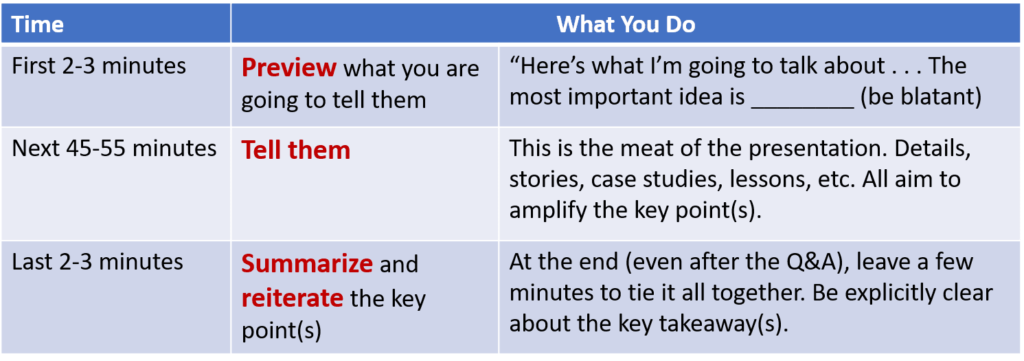Define the one important point you want to make.
I recently watched a webinar where the presenter had almost 200 slides. He began by saying, “I have a lot to cover, so let’s get started.” After sprinting through his slides, he wrapped up with, “I hope you found that helpful.”
Helpful? I had no idea what he said. To say his presentation was overwhelming is a massive understatement. (I was hired to summarize this webinar, so I listened to the whole thing, but I wonder how many attendees actively chose to stay to the very end. I doubt there were many.
This is an extreme example, but we’ve probably all experienced something similar where the presenter:
- Had way too many slides (“Death by PowerPoint”)
- Talked fast to jam it all in
- Is an expert on a topic – and wanted to convey all their knowledge in 1 hour
Was this webinar effective at generating leads? Creating thought leadership? Building the company’s brand? Teaching attendees about an innovative technology? I struggle to believe these goals were accomplished.
An Opposite Approach: “The Big Big”
During this webinar, it occurred to me the presenter had never worked for Robin, my boss years ago at an Israeli technology consulting firm. When preparing for a client presentation or to bring order to a chaotic meeting, she would loudly ask in a combination of English and Hebrew, “What’s the Gadol Gadol?” (Gadol being Hebrew for “big.”) Literally, she was asking, “What is the Big Big?”
By this she meant, what is the ONE BIG IDEA of this presentation or meeting? What’s the one most important point? The one thing we want to be sure everyone hears, understands, and leaves with?
When I speak, I think about, “What is the one big idea I want to make sure everyone gets?” And, I’m grateful when speakers are explicit in saying, “If you get just one thing from this webinar or virtual meeting, it is ______.”
(Defining your webinar’s one big idea reminds me of the scene in City Slickers where Jack Palance tells Billy Crystal to figure out his one thing.)
Using Structure to Ensure Focus
My client and friend Jack – who has spoken at hundreds of conferences and webinars and has advised hundreds of speakers on best practices – uses a simple structure that brings Robin’s idea to life. (Maybe you do something similar.)

In listening to numerous webinars, I appreciate when a speaker or moderator takes two minutes at the end to summarize an hour-long discussion and emphasizes the most important point (or a few points).
I’ll do the same here:
- Don’t use tons of slides. You will lose your audience.
- In preparing, define your “Big Big” – the one most important point you want to make.
- Think about the structure of the session and decide how best to communicate this main idea throughout the session.
- Leave time (even 1 minute) to clearly summarize and reiterate your most important point(s).
You worked hard to prepare for the webinar, attract attendees, and execute the webinar. Make sure attendees leave with a clear understanding of the main point you wanted to communicate.
By focusing your message, you are most likely to achieve your webinar’s goals of engaging and educating your audience, building your brand, creating thought leadership, and generating leads.
Let us know:
- How do you decide on the most important idea you want to communicate?
- What techniques do you use to ensure your webinars convey your most important ideas?
- How do you currently end your webinars?
- What do you do after your webinars to disseminate your main idea?
To learn more about how BullsEye Resources can help you increase the value of your webinars, visit bullseyeresources.com or contact us at info@bullseyersesources.com.



Leave A Comment